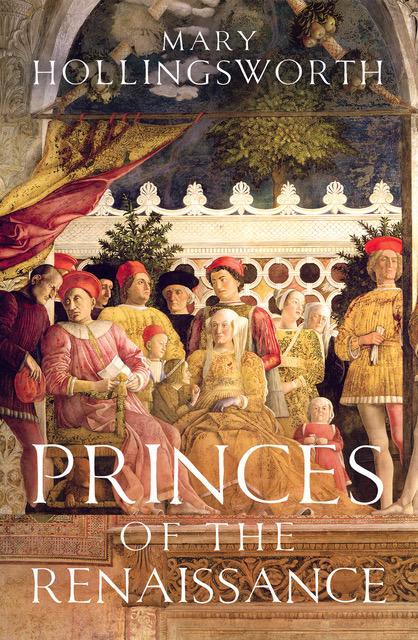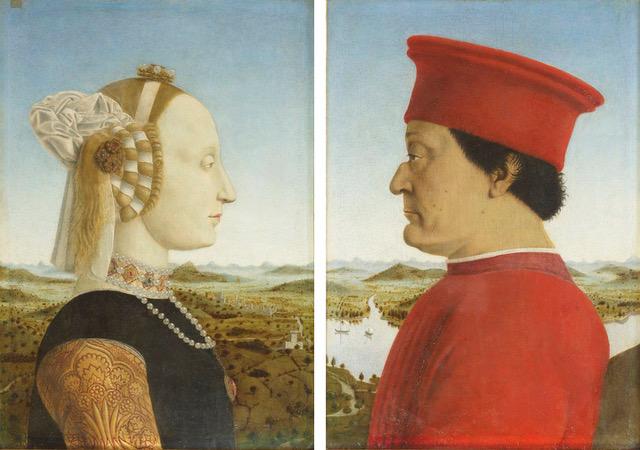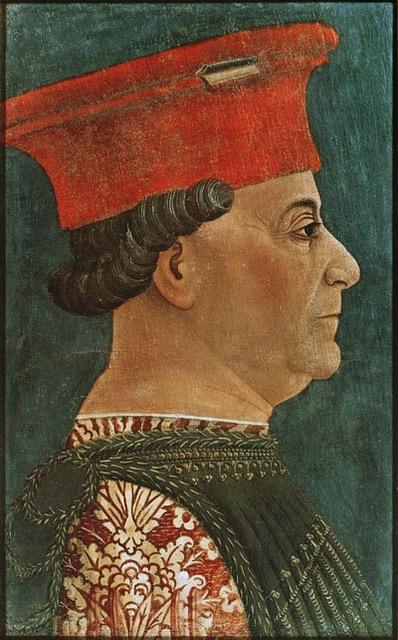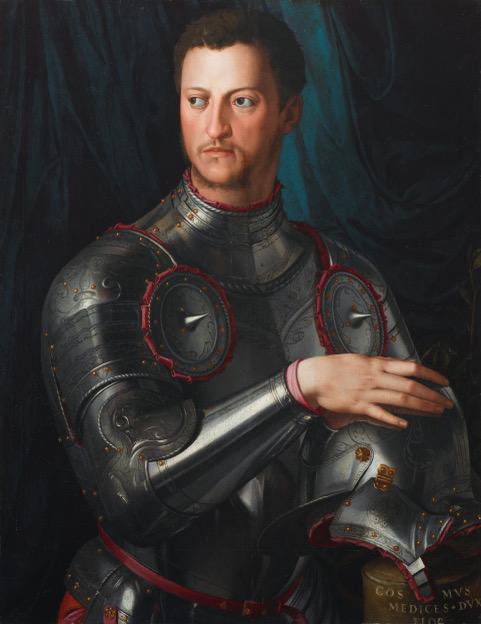
If there is anything better that Italian food then it is Italian history in the form of food for thought – and nothing comes better than Princes of the Renaissance by Mary Hollingsworth (£35 Head of Zeus). This lavishly illustrated book is a gorgeous presentation of a period so riddled with scandal, salaciousness, genius and breakthrough that it comes as no surprise that it was Italians who invented opera. In fact, not to do it an injustice, it reads like one vast gossip column of history and historical fact. It is a sweeping look at the figures and the personalities behind one of the most recognizable eras in European cultural and political history, an era when kings, princes and popes could, and did, get away with sheer blue murder – and when it is Italian in flavour the murder is endurably operatic. This is a book in which passions run high, in which the stakes are always higher and the art is in orbit around the whole, snuggly tucked in by an intellectual banket of philosophical breakthrough and religious hypocrisy.

From the scheming of the Farnese Pope Paul III and his family’s ascendancy to the sheer awfulness of the Borgia Pope, Rodrigo Borgia a.k.a. Alexander VI, this is an unputdownable treat for those who, fed up in the present situation of eternal groundhog days would like to scheme along with more than half the characters in this book.

It is also a glimpse of the old design of Italy before its unification, an Italy of city states, and city against city – and all of this was played out in the many papal elections that took time over the course of the periods of which the author writes. The Vatican is at the epicentre of it all. It is the microcosm compared to the macrocosm – and serves as the theatre upon which the opera plays out.

This is astutely observed book, rich in detail and as lavish as the banquets discussed therein. The story of the Farnese is wonderfully well-told and, allied to the wonderful use of illustrations embedded throughout the book, one gets a very pictorial flavour of the whole as knives plunge and families rise and popes condemn – but only with an eye to their own power bases. Upon the operatic theme Hollingsworth is a sympathetic author who reaches out to the poor unfortunates of history whose doom it was to wait for centuries before having their names cleared by the judgment of those well qualified to give it. Such is the pace of the book that the pace seems sometimes breathless and we wonder aloud quite who is worthy of sympathy and who not? The sympathy of the historian is, in this instance, not only a guide to the reader but also a means of giving pause before we inflict our own moral standards upon the past: something that seems to be happened all too often in these heavily polarised times. The author is an excellent guide and I cannot recommend this work more highly, please I beg you, buy it – it is far better than television.
The departure of the Romans from Britain in the fifth century coincided with the rise of Christianity in these islands, with the coming of St Augustine to Kent: he was also the first Archbishop of Canterbury. St Augustine was not the first Christian in these islands thus he not the first Christian to preach and to convert here. There had been an early outcrop of Christians in these islands from 37AD. This is a singular and astonishing fact, coming so soon after the accepted date of the. Crucifixion. However, the coming of Christianity also coincided with the period that is now known to us as the Dark Ages: it came in the immediate aftermath of the departure of Rome. In The First Kingdom (Head of Zeus £30) Max Adams tells the story of what happened in Britain between the departure of Rome and the rise of the Middle Ages. He begins with the description of a Roman Curse Tablets found at Uley in Gloucestershire, through the writings of Gildas, a sixth century Monk whose De Excidio et Conquestu Britanniae recounts the history of the Britons – and the coming of the Saxons. From then onwards he seeks to recount the unknowns and this he does with considerable panache.
Massively detailed, this is how history should be written, the book is like John Morris’s ground-breaking The Age of Arthur, thoroughly comprehensive and replete with enormous scholarship – he has assembled every single detail of what the Dark Age was like in this country. This is no mean feat. Not since The Age of Arthur was published has something so very comprehensive been written. He has been to the newly found Dark Age villages and seen the various distinctions between the differing peoples in order to get hold of such exquisite detail – and the whole builds very satisfactorily to its conclusion. In speaking to one scholar of the period who is also reading the book he made the comment that there is much less to disagree with than usual, I couldn’t agree more. This was the age that ‘set’ history, seeing the translation from Roman Britain to the United Kingdom, but this time in a compelling overview that draws you into its embrace and allows the fog to clear as he reaches the book’s climax. Recommended reading.
Travels in the Otherworld and Fantastic Other Realms, Claude and Corinne Lecouteux (Inner Traditions, $30) is subtitled Medieval Journeys into the Beyond and is a charming foray into Medaeval romance and its ideas of what the world around us (and within us) looked like to the writer in the Middle Ages. It is essentially a travelogue – but not as you might know it. In the courtly world of Medaeval Europe the world beyond the walled garden (Arabic paradise) was a place of fear, beyond Christian redemption and a place possibly of demons too – demons that sometimes came in human form. These tales take us into the perilous realm of Faery and into other pagan lands.
‘I brought guides because I wished to push through the desert towards the plough. They advise me against this course because of the wild beasts living there, but I ignored them. We came to a region with many ravines, where the road was narrow and steep sided, and for eight days we encountered strange and unknown animals.
We finally entered a large forest of trees called An aphanta, which produced a most peculiar fruit: enormous apples as large as gourds…’
So says Alexander the Great, newly installed as conqueror of Persia and now on the quest for immortality. In these borderlands he encounters, almost inevitably, giants of enormous size and exotic oddities. Because they are very far away from their comfort zone there is very much a propensity to exaggerate size and presence. It is a telling facet of the writing of the period. Charming, exquisite and wonderfully naive.
A wicked knight by the name of Tundale, a native of southern Iberia (Spain) falls over whilst at the house of one of his debtors. He is, to his inexpressible sorrow, in a catatonic state. A handsome man of noble birth he also very cruel. God has decided to punish him whilst at the supper table – hence his catatonia, and what follows is a very interesting, though thoroughly medaeval, near-death experience. The experience last three days and in this detached state encounters devils, demons and an inconvenient inability to return to his own body. What follows is a pre-Dantean journey to the infernal region. The book is accompanied by rare illustrations of the glimpse of hell – as well as of heaven and other fantastic realms. A charming excursion.
In the same vein Esoteric Mysteries of the Underworld: The Power and Meaning of Sacred Spaces by Jean-Pierre Bayard (Inner Traditions, £29.99) offers us a serious excursion into the subterranean depths. This is a well-written and well-informed work, ably translated by Jon Graham from its original French. From source to rock to stone and to water we are given a superb travelogue through inherent meanings, symbol and history. The author bemoans the lack of written sources in the ancient and no so ancient period because, as he points out, Druidism, the mysterious guardian of all that had gone before, ‘only transmitted by word of mouth and avoids the written word.’ Here the author references the large menhirs of northern and central France and their silent testimony to the past and the birth of our culture. It is the beginning of a journey that offers many questions and seeks to answer them in what amounts to a journey of the human soul not only through its past but also into its very sense of being. Do not think ‘religion’ think instead of ancient humanity emerging from its early troglodytic existence into a new dawning of its own awareness. Tolkien reflects on this throughout his fictional and non-fictional works: it is the very essence of true spiritual thinking, a thinking based upon proper enquiry but also on intellectual rigour that does not exclude the very possibility of the spiritual and emotional. Menhirs were an emotional response to the ‘new’ world, as was much else in the early subterranean world in the days when we thought of it as a womb. Indeed, many temples have underground vaults designed for this very purpose to ‘rebirth’ the soul and to feed the spirit. The Great Pyramid is a possible example.
This is a very capacious read in the sense that it offers so many anecdotes and insights. A profound read.
David Elkington

Previous praise for Mary Hollingsworth’s The Medici:
‘An excellent study of the Medici … A careful, understated book … [It] is never short on drama’
Helen Castor, Telegraph Book of the Year.
‘A lucid and beautifully illustrated family history. In Hollingsworth’s surefooted telling, this ruthless but enlightened family were at their best when they were true to the Florentine motto of “prot and honour”‘
Sunday Times Book of the Week.
A detailed and perceptive history of the Renaissance told through the lives of its most influential patrons.
From the late Middle Ages the independent city-states were taken over by powerful families who installed themselves as dynastic rulers. Many of these princes were mercenary soldiers, earning their livings on the battlefield. Closely related by blood or marriage, they created a network of alliances and rivalries, and an endless cycle of war and diplomacy.
Encouraged by the humanists they employed as secretaries, they immersed themselves in the culture of antiquity, commissioning palaces, villas and churches inspired by the architecture of their ancient Roman forebears.
In a narrative that is as rigorous and closely researched as it is accessible and informative, Mary Hollingsworth sets the princes’ aesthetic achievements in the context of the volatile, ever-shifting politics of a tumultuous period of history.
Mary Hollingsworth is available for interview and to write articles. For further information and review copies of Princes of the Renaissance
Please contact: Gabriella Drinkald on [email protected] Tel: 07894 587828
